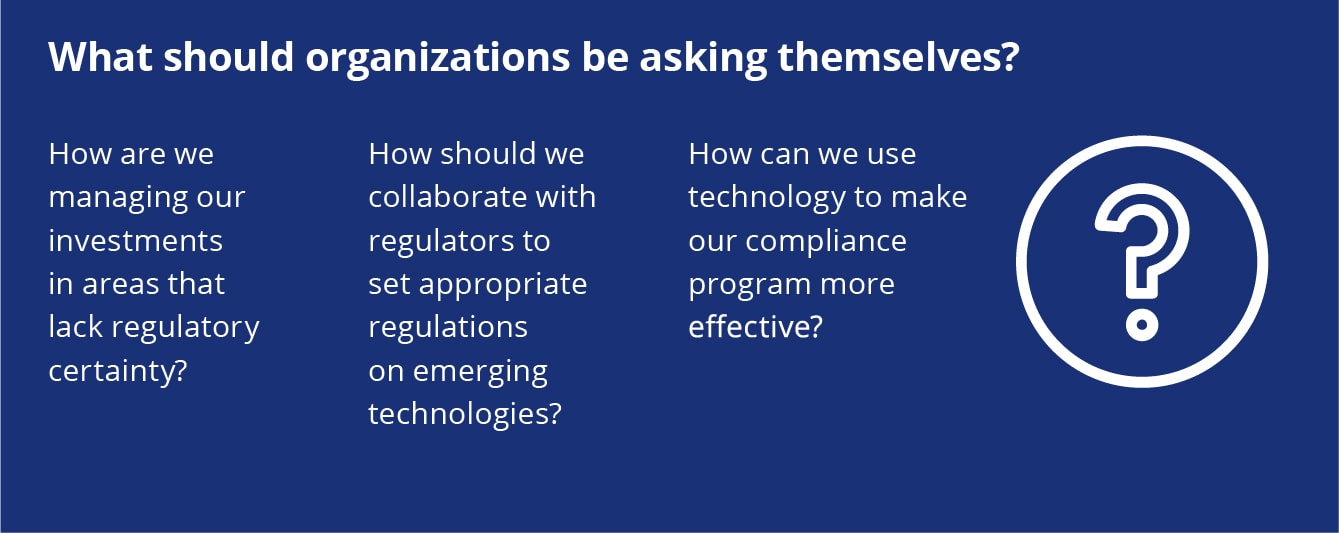Navigating regulatory change for emerging technologies has been saved

Analysis
Navigating regulatory change for emerging technologies
Future of risk in the digital era
Regulatory changes focused on emerging technologies begin to affect business models and increase complexity of compliance.
Explore content
- Why is this trend important today?
- Where has this trend had an impact?
- What does this mean for organizations?
- How can organizations respond?
- What should organizations be asking themselves?
Why is this trend important today?
This article is one of nine trends outlined in Deloitte's Future of risk in the digital era report.
Emerging business and service models suggest that innovation continues to outpace regulation. In such an environment, regulators ask themselves: How do we protect consumers and ensure transparent markets while allowing innovation and business to flourish?
Regulatory and supervisory bodies are adopting more flexible approaches to develop policy (such as regulatory sandboxes, outcome-based regulation, risk-weighted regulation, and adaptive regulation), considering supervisory technologies to provide oversight, and publishing guidelines in emerging technology topics (such as data privacy, algorithmic decision making, autonomous vehicles, and initial coin offerings). A fluid regulatory environment gives organizations an opportunity to influence regulations and modernize their approaches to compliance for enhanced effectiveness and cost efficiencies.
Where has this trend had an impact?
- Ten organizations have partnered with the US government to collaboratively test the use of unmanned aerial vehicles in an environment that allows them to experiment with uses currently forbidden by federal law.
- Businesses based on sharing platforms are facing tough regulatory oversight globally, which is likely to affect their revenue. The fear that regulatory actions may limit benefits of emerging technologies is causing organizations to adopt a wait-and-watch approach to innovation.
- California’s Consumer Privacy Act requires organizations to let customers opt out of having their data sold while prohibiting companies from charging a customer or treating them differently for having done so, causing Internet service giants to reconsider their business models.

What does this mean for organizations?
- Reduced speed of adoption of emerging technologies and their use, such as blockchain and autonomous cars, due to lack of regulatory clarity.
- Loss of investments and future revenue as new regulations potentially render existing business models ineffective or infeasible.
- Frequent changes to business models or operations due to regulatory changes during a product or service life cycle.
Increased cost of compliance driven by complex, varying, and sometimes conflicting regulations.- Increased competitive pressures as new unregulated entrants have the freedom to operate in ways that existing regulated organizations can’t.

How can organizations respond?
- Educate regulators and explore emerging technology impacts together to contribute to the development of regulations that protect public interest without impeding innovation.
- Create policies and standards on the use of emerging technology through industry-driven collaborative standard setting and self-regulating bodies.
- Clarify the organization’s risk appetite when evaluating projects that lie outside current regulations.
- Use AI technologies for continuous horizon scanning to identify new regulations, track amendments to existing regulations, and understand the associated effects to the organization.
- Train product and technology professionals on risk concepts to be better prepared to comply with emerging regulations while innovating with emerging technologies.


Return to the main report:
Let’s talk
Contact us to discuss how you can better prepare for what’s ahead. We can help you identify ways for your organization to manage risk, create value, and ultimately power your performance.
Recommendations
Financial Services RegPulse Newsletter
Concise summaries of select regulatory developments
Compliance modernization is no longer optional
How evolved is your approach?







